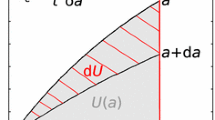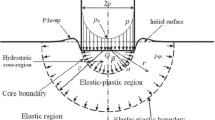Abstract
Indentation tests were performed, using a flat punch probe, on silicone gels to induce failure under compression. The silicone gels were formed from networks of vinyl-terminated polydimethylsiloxane (PDMS) with molecular weights of 800 and 28,000 g/mol and a sol fraction of trimethylsiloxy-terminated PDMS with molecular weights ranging from 1250 to 139,000 g/mol. Cone cracks were observed in samples that fractured from defects at the sample surface, but failure more commonly originated from the corners of the indenter. Ring cracks were observed for the most highly compliant samples that fractured at indentation depths approaching the overall thickness of the sample. In these cases we generally observed a delayed fracture response, with a time delay that increased with increasing sol fraction and decreased with increasing indentation load.
Similar content being viewed by others

References
B. Lawn and R. Wilshaw: Indentation fracture—Principles and applications. J. Math. Sci. 10, 1049 (1975).
H. Chai and B.R. Lawn: Fracture mode transitions in brittle coatings on compliant substrates as a function of thickness. J. Mater. Res. 19, 1752 (2004).
H. Chai and B.R. Lawn: Failure of brittle layers on polymeric substrates from Vickers indentation. Scr. Mater. 55, 335 (2006).
R. Lach, L.A. Gyurova, and W. Grellmann: Application of indentation fracture mechanics approach for determination of fracture toughness of brittle polymer systems. Pohm. Test. 26, 51 (2007).
O.A. Shergold and N.A. Fleck: Mechanisms of deep penetration of soft solids, with application to the injection and wounding of skin. Proc. R. Soc. London, Ser. A 460, 3037, (2004).
O.A. Shergold and N.A. Fleck: Experimental investigation into the deep penetration of soft solids by sharp and blunt punches, with application to the piercing of skin. Trans. ASME 127, 838 (2005).
M.A. Cox, N.J.B. Driessen, C.V.C. Bouten, and F.P.T. Baaijens: Mechanical characterization of anisotropic planar biological soft tissues using large indentation: A computational feasibility study. Trans. ASME 128, 428 (2006).
C. Nguyen and T. Vu-Khanh: Mechanics and mechanisms of puncture of elastomer membranes., J. Math. Sci. 39, 7361 (2004).
N. Gilra, C. Cohen, R.M. Briber, B.J. Bauer, R.C. Hedden, and A.Z. Panagiotopoulos: A SANS study of the conformational behavior of linear chains in compressed and uncompressed end-linked elastomers. Macromolecules 34, 7773 (2001).
K. McLoughlin, J.K. Waldbieser, C. Cohen, and T.M. Duncan: End-linked poly(dimethylsiloxane) elastomers: 2H-nuclear magnetic resonance investigations of compression-induced segment anisotropy. Macromolecules 30, 1044 (1997).
S.K. Patel, S. Malone, C. Cohen, J.R. Gillmor, and R.H. Colby: Elastic modulus and equilibrium swelling of poly(dimethylsiloxane) networks. Macromolecules 25, 5241 (1992).
A.L. Larsen, K. Hansen, P. Sommer-Larsen, O. Hassager, A. Bach, S. Ndoni, and M. Jorgensen: Elastic properties of nonstoichiometric reacted PDMS networks. Macromolecules 36, 10063 (2003).
A.J. Chalk and J.F. Harrod: Homogeneous catalysis. II. The mechanism of the hydrosilation of olefins catalyzed by Group VIII metal complexes. J. Am. Chem. Soc. 87, 16 (1965).
P.L. Drzal and K.R. Shull: Origins of mechanical strength and elasticity in thermally reversible, acrylic triblock copolymer gels. Macromolecules 36, 2000 (2003).
W-C. Lin, K.R. Shull, C.Y. Hui, and Y-Y. Lin: Contact measurement of Internal fluid flow within poly(n-isopropyl acrlyamide gels)., J. Chem. Phys. 127, 094906 (2007).
I.N. Sneddon: The relation between load and penetration in the axisymmetric Boussinesq problem for a punch of arbitrary profile. Int. J. Eng. Sci. 3, 47 (1965).
K.R. Shull: Contact mechanics and the adhesion of soft solids. Mater. Sci. Eng., R 36, 1 (2002).
E.M. Valles and C.W. Macosko: Properties of networks formed by end linking of poly(dimethylsiloxane). Macromolecules 12, 673 (1979).
M. Gottlieb, C.W. Macosko, G.S. Benjamin, K.O. Meyers, and E.W. Merrill: Equilibrium modulus of model poly(dimethylsiloxane) networks. Macromolecules 14, 1039 (1981).
S.H. Yoo, C. Cohen, and C.Y. Hui: Mechanical and swelling properties of PDMS interpenetrating polymer networks. Polymer (Guildf.) 47, 6226 (2006).
R. Mrozek and J. Lenhart: unpublished results.
A.N. Gent: Compression of rubber blocks. Rubber Chem. Technol. 67, 549 (1994).
A.N. Gent: A new constitutive relation for rubber. Rubber Chem. Technol. 69, 59 (1996).
V.R. Krishnan and C-Y. Hui: Large deformation of soft elastic materials in adhesive contact with a rigid cylindrical flat punch. Soft Matter 4, 1909 (2008).
M.E. Seitz, D. Martina, T. Baumberger, V.R. Krishnan, C-Y. Hui, and K.R. Shull: Fracture and large strain behavior of self-assembled triblock copolymer gels. Soft Matter 5, 447 (2009).
C. Kocer and R.E. Collins: Angle of Hertzian cone cracks. J. Am. Ceram. Soc. 81, 1736 (1998).
T. Baumberger, C. Caroli, and D. Martina: Fracture of a biopolymer gel as a viscoplastic disentanglement process. Eur. Phys. J. E. 21, 81 (2006).
T. Baumberger, C. Caroli, and D. Martina: Solvent control of crack dynamics in a reversible hydrogel. Nat. Mater. 5, 552 (2006).
Author information
Authors and Affiliations
Corresponding author
Rights and permissions
About this article
Cite this article
Lin, WC., Otim, K.J., Lenhart, J.L. et al. Indentation fracture of silicone gels. Journal of Materials Research 24, 957–965 (2009). https://doi.org/10.1557/jmr.2009.0128
Received:
Accepted:
Published:
Issue Date:
DOI: https://doi.org/10.1557/jmr.2009.0128



